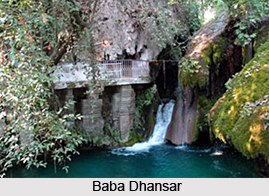 The divine place of Baba Dhansar is located 17km from Reasi towards Katra in Udhampur. The approach path involves a walk of 1km from the road. It is a mythical belief that when Lord Shiva travelled to the Amarnath caves to tell Goddess Parvati the story of his immortality, he left his serpent king, Sheshnag at Anantnag. Sheshnag transformed himself in the physical body of Vasudev. One of the sons of Vasudev was Dhansar who was an angelic person. As the local belief goes, in the ancient times there was a demon who lived near Karua Jheel who committed mayhem on the people of village Karua.
The divine place of Baba Dhansar is located 17km from Reasi towards Katra in Udhampur. The approach path involves a walk of 1km from the road. It is a mythical belief that when Lord Shiva travelled to the Amarnath caves to tell Goddess Parvati the story of his immortality, he left his serpent king, Sheshnag at Anantnag. Sheshnag transformed himself in the physical body of Vasudev. One of the sons of Vasudev was Dhansar who was an angelic person. As the local belief goes, in the ancient times there was a demon who lived near Karua Jheel who committed mayhem on the people of village Karua.
The villagers sought the help of Baba Dhansar to get rid of the demon. Lord Shiva arrived in the spot and helped the men to slay the demon. The temple of Baba Dhansar and a cave of Lord Shiva near the Jheel has become an eponymous place of worship now. Karua Jheel is considered sacred, where bathing is not permitted. Though, the devotees can take a bath downstream. People believe that their wishes are fulfilled if they take a dip in the stream and pray honestly with heart and soul. A large number of devotees visit the place every year, particularly on the day of Maha Shivratri when an annual fair (mela) is held.





















